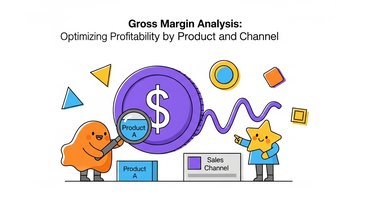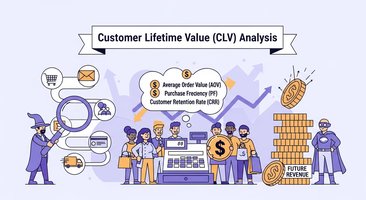Running a successful Amazon FBA business requires more than just finding profitable products and optimizing listings. In today's competitive marketplace, the difference between thriving sellers and those who struggle often comes down to one critical factor: financial analytics. Amazon FBA financial analytics involves tracking, measuring, and analyzing key financial metrics that directly impact your business's profitability and growth. By understanding these metrics, you can make data-driven decisions that optimize your operations, improve cash flow, and scale your business effectively.
Why Amazon FBA Financial Analytics Matter
The Amazon marketplace is more competitive than ever, with over 9.7 million sellers worldwide. Without proper financial analytics, you're essentially flying blind. Here's why financial analytics are crucial for FBA sellers:
Data-Driven Decision Making: Financial analytics provide concrete data to guide your business decisions, from product sourcing to pricing strategies.
Profit Optimization: Understanding your true profit margins helps identify which products are actually profitable and which are draining resources.
Cash Flow Management: Proper analytics help you predict and manage cash flow, preventing stockouts and overstock situations.
Scaling Opportunities: Analytics reveal which aspects of your business are ready for scaling and which need improvement first.
Risk Management: Financial metrics help identify potential problems before they become critical issues.
Essential Amazon FBA Financial Metrics Every Seller Should Track
1. Gross Profit Margin
Gross profit margin is the percentage of revenue remaining after deducting the cost of goods sold (COGS). This metric shows how efficiently you're pricing your products relative to their cost.
Formula: (Revenue - COGS) / Revenue × 100Why It Matters: A healthy gross profit margin ensures you have enough buffer to cover Amazon fees, advertising costs, and other operational expenses while maintaining profitability.
Target Range: Most successful FBA sellers aim for gross profit margins between 40-60%.
2. Net Profit Margin
Net profit margin represents the percentage of revenue that remains as profit after all expenses are deducted, including Amazon fees, advertising costs, and operational expenses.
Formula: Net Profit / Total Revenue × 100
Why It Matters: This is your true profitability metric. A positive net profit margin indicates a sustainable business model.
Target Range: Healthy FBA businesses typically maintain net profit margins between 15-25%.
3. Return on Investment (ROI)
ROI measures the efficiency of your investment in inventory and business operations.
Formula: (Net Profit / Total Investment) × 100
Why It Matters: ROI helps you evaluate which products and strategies generate the best returns on your invested capital.
Target Range: Successful FBA sellers typically achieve ROI of 100% or higher annually.
4. Inventory Turnover Rate
This metric measures how quickly you sell and replace inventory over a specific period.
Formula: COGS / Average Inventory Value
Why It Matters: Higher turnover rates indicate efficient inventory management and better cash flow. Low turnover can signal overstocking or poor product selection.
Target Range: Most FBA sellers aim for inventory turnover rates between 4-12 times per year.
5. Customer Acquisition Cost (CAC)
CAC represents the average cost to acquire a new customer through advertising and marketing efforts.
Formula: Total Advertising Spend / Number of New Customers Acquired
Why It Matters: Understanding CAC helps optimize advertising spend and evaluate the sustainability of your marketing strategies.
6. Lifetime Value (LTV)
LTV estimates the total revenue a customer will generate throughout their relationship with your brand.
Formula: Average Order Value × Purchase Frequency × Customer Lifespan
Why It Matters: LTV helps determine how much you can afford to spend on customer acquisition while maintaining profitability.
7. Advertising Cost of Sales (ACoS)
ACoS measures the percentage of sales spent on advertising.
Formula: (Ad Spend / Ad Revenue) × 100
Why It Matters: ACoS helps optimize advertising campaigns and ensures advertising spend contributes to overall profitability.
Target Range: Most profitable FBA sellers maintain ACoS between 15-30%, depending on their profit margins.
Advanced Amazon FBA Financial Analytics
Cash Flow Analysis
Cash flow is the lifeblood of any FBA business. Proper cash flow analysis involves tracking:
- Operating Cash Flow: Money generated from core business operations
- Inventory Investment: Capital tied up in inventory
- Seasonal Variations: How cash flow changes throughout the year
- Payment Cycles: Amazon's payment schedule and its impact on cash flow
Product-Level Profitability Analysis
Not all products contribute equally to your bottom line. Product-level analysis helps identify:
- Star Performers: Products with high profit margins and strong sales
- Cash Cows: Consistent sellers with steady profits
- Problem Products: Items that drain resources without adequate returns
- Seasonal Opportunities: Products with predictable seasonal demand patterns
Market Share Analysis
Understanding your position in the market helps with strategic planning:
- Category Performance: How your products perform within their categories
- Competitive Positioning: Your market share relative to competitors
- Growth Opportunities: Underserved market segments with potential
Essential Tools for Amazon FBA Financial Analytics
Amazon Seller Central Reports
Amazon provides several built-in reports that offer valuable financial insights:
- Business Reports: Sales, traffic, and conversion data
- Payment Reports: Detailed breakdown of fees and payments
- Inventory Reports: Stock levels and inventory performance
- Advertising Reports: Campaign performance and spending data
Third-Party Analytics Tools
While Amazon's native tools are helpful, third-party solutions often provide more comprehensive analytics:
- Helium 10: Comprehensive suite including profit tracking
- Jungle Scout: Sales analytics and profit calculations
- ManageByStats: Detailed financial reporting and analytics
- Sellics (now Perpetua): Advanced analytics and optimization tools
Automated Financial Management Solutions
For sellers managing multiple products and channels, automated solutions like Klavena can provide:
- Real-time Profit Tracking: Instant visibility into profitability across all products
- Multi-channel Integration: Consolidated reporting across Amazon, Shopify, eBay, and other platforms
- Automated Expense Allocation: Proper attribution of costs to specific products and channels
- Cash Flow Forecasting: Predictive analytics for better financial planning
- Tax Preparation: Automated categorization and reporting for tax purposes
How to Implement Financial Analytics in Your FBA Business
Step 1: Establish Baseline Metrics
Start by calculating your current performance across all essential metrics. This baseline will help you measure improvement over time.
Step 2: Set Up Tracking Systems
Implement systems to automatically track and record financial data. Manual tracking is prone to errors and becomes unmanageable as your business grows.
Step 3: Create Regular Reporting Schedules
Establish weekly, monthly, and quarterly reporting schedules to review performance and identify trends.
Step 4: Analyze and Act on Data
Regular analysis is only valuable if you act on the insights. Create action plans based on your findings.
Step 5: Continuously Optimize
Use your analytics to continuously refine your strategies, from product selection to pricing and advertising.
Common Financial Analytics Mistakes FBA Sellers Make
1. Ignoring Hidden Costs
Many sellers focus only on obvious costs like COGS and Amazon fees, overlooking expenses like:
- Storage fees and long-term storage charges
- Return processing fees
- Advertising costs
- Inventory carrying costs
- Opportunity costs of tied-up capital
2. Not Tracking Product-Level Profitability
Averaging profitability across all products can mask serious issues. Some products may be highly profitable while others lose money.
3. Focusing Only on Revenue
High revenue doesn't guarantee profitability. Focus on profit margins and cash flow, not just top-line sales.
4. Irregular Monitoring
Checking metrics sporadically makes it difficult to identify trends and respond to problems quickly.
5. Analysis Paralysis
While data is important, don't let over-analysis prevent you from taking action. Focus on the most impactful metrics first.
Leveraging Financial Analytics for Business Growth
Product Portfolio Optimization
Use analytics to optimize your product mix:
- Identify top performers and consider expanding similar product lines
- Eliminate underperformers that drag down overall profitability
- Rebalance inventory based on performance data
Pricing Strategy Refinement
Financial analytics inform smarter pricing decisions:
- Test price elasticity to find optimal price points
- Monitor competitor pricing and adjust accordingly
- Implement dynamic pricing based on demand and inventory levels
Inventory Management
Analytics-driven inventory management improves cash flow:
- Optimize reorder points based on sales velocity
- Reduce carrying costs through better demand forecasting
- Minimize stockouts while avoiding overstock situations
Marketing and Advertising Optimization
Use financial data to improve marketing ROI:
- Allocate advertising budget to highest-performing campaigns
- Optimize keyword bidding based on profitability, not just sales volume
- Test new marketing channels with proper tracking and measurement
The Role of Automation in FBA Financial Analytics
As your FBA business grows, manual tracking becomes increasingly difficult and error-prone. Automation tools can help by:
Streamlining Data Collection
Automated systems can pull data from multiple sources, including:
- Amazon Seller Central
- Advertising platforms
- Inventory management systems
- Accounting software
Providing Real-Time Insights
Instead of waiting for month-end reports, automated systems provide real-time visibility into key metrics.
Reducing Human Error
Automated calculations eliminate the risk of manual errors in financial reporting.
Enabling Scalability
Automation allows you to manage financial analytics across hundreds or thousands of products without proportionally increasing workload.
Industry Benchmarks and Performance Standards
Understanding industry benchmarks helps evaluate your performance:
Profit Margins by Category
Different product categories have varying profit margin expectations:
- Electronics: 10-20% net margin
- Home & Garden: 20-30% net margin
- Health & Beauty: 25-35% net margin
- Sports & Outdoors: 15-25% net margin
Inventory Turnover Rates
Target turnover rates vary by product type:
- Fast-moving consumer goods: 8-12 times per year
- Seasonal products: 4-6 times per year
- Durable goods: 3-5 times per year
Advertising Performance
Benchmark ACoS varies by category and competition level:
- Highly competitive categories: 25-35% ACoS
- Moderately competitive: 15-25% ACoS
- Low competition: 10-20% ACoS
Future Trends in Amazon FBA Financial Analytics
Artificial Intelligence and Machine Learning
AI-powered analytics tools are becoming more sophisticated, offering:
- Predictive analytics for demand forecasting
- Automated optimization of pricing and inventory
- Anomaly detection for identifying unusual patterns
Integration with External Data Sources
Future analytics platforms will integrate with more data sources:
- Market research data for competitive intelligence
- Economic indicators for demand forecasting
- Social media sentiment for brand monitoring
Real-Time Decision Making
Advanced analytics will enable real-time decision making:
- Dynamic pricing based on market conditions
- Automated inventory reordering based on predictive models
- Campaign optimization in real-time
Getting Started with Klavena's Financial Analytics
For FBA sellers looking to implement comprehensive financial analytics, Klavena offers a complete solution designed specifically for ecommerce businesses:
Comprehensive Integration
Klavena seamlessly integrates with:
- Amazon Seller Central
- Multiple marketplace platforms
- QuickBooks and other accounting systems
- Advertising platforms
Real-Time Financial Tracking
Get instant visibility into:
- Product-level profitability
- Cash flow status
- Inventory performance
- Advertising ROI
Automated Reporting
Receive automated reports on:
- Weekly performance summaries
- Monthly financial statements
- Quarterly business reviews
- Annual tax preparation documents
Expert Support
Klavena provides ongoing support to help you:
- Interpret financial data
- Identify optimization opportunities
- Implement best practices
- Scale your business effectively
Conclusion
Amazon FBA financial analytics are essential for building a sustainable, profitable business in today's competitive marketplace. By tracking the right metrics, using appropriate tools, and acting on data-driven insights, you can optimize your operations, improve profitability, and scale your business effectively. Remember that financial analytics is not a one-time activity but an ongoing process. As your business grows and market conditions change, your analytics needs will evolve as well. The key is to start with the basics, build good habits, and gradually sophisticate your approach as you gain experience and grow your business. Whether you're just starting your FBA journey or looking to optimize an existing business, implementing robust financial analytics will provide the foundation for long-term success. Consider partnering with specialized solutions like Klavena to automate and streamline your financial management, allowing you to focus on what you do best: growing your business.





